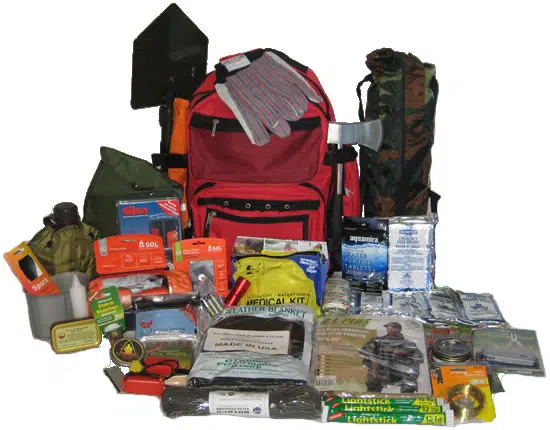Basic Disasters Supplies Kit
A basic emergency preparedness kit could include the following recommended items:
- Water, one gallon of water per person per day for at least three days, for drinking and sanitation
- Food, at least a three-day supply of non-perishable food
- Battery-powered or hand crank radio and a NOAA Weather Radio with tone alert and extra batteries for both
- Flashlight and extra batteries
- First aid kit
- Whistle to signal for help
- Dust mask to help filter contaminated air and plastic sheeting and duct tape to shelter-in-place
- Moist towelettes, garbage bags and plastic ties for personal sanitation
- Wrench or pliers to turn off utilities
- Manual can opener for food
- Local maps
- Cell phone with chargers, inverter or solar charger
Additional Emergency Supplies
Once you have gathered the supplies for a basic emergency kit, you may want to consider adding the following items:
- Prescription medications and glasses
- Infant formula and diapers
- Pet food and extra water for your pet
- Cash or traveler’s checks and change
- Important family documents such as copies of insurance policies, identification and bank account records in a waterproof, portable container. You can use the Emergency Financial First Aid Kit – EFFAK (PDF – 977Kb) developed by Operation Hope, FEMA and Citizen Corps to help you organize your information.
- Emergency reference material such as a first aid book or free information from this web site. (See Publications)
- Sleeping bag or warm blanket for each person. Consider additional bedding if you live in a cold-weather climate.
- Complete change of clothing including a long sleeved shirt, long pants and sturdy shoes. Consider additional clothing if you live in a cold-weather climate.
- Household chlorine bleach and medicine dropper – When diluted, nine parts water to one part bleach, bleach can be used as a disinfectant. Or in an emergency, you can use it to treat water by using 16 drops of regular household liquid bleach per gallon of water. Do not use scented, color safe or bleaches with added cleaners.
- Fire extinguisher
- Matches in a waterproof container
- Feminine supplies and personal hygiene items
- Mess kits, paper cups, plates, paper towels and plastic utensils
- Paper and pencil
- Books, games, puzzles or other activities for children
First Aid Kit
In any emergency a family member or you yourself may suffer an injury. If you have these basic first aid supplies you are better prepared to help your loved ones when they are hurt.
Knowing how to treat minor injuries can make a difference in an emergency. You may consider taking a first aid class, but simply having the following things can help you stop bleeding, prevent infection and assist in decontamination.
- Two pairs of Latex or other sterile gloves if you are allergic to Latex
- Sterile dressings to stop bleeding
- Cleansing agent/soap and antibiotic towelettes
- Antibiotic ointment
- Burn ointment
- Adhesive bandages in a variety of sizes
- Eye wash solution to flush the eyes or as general decontaminant
- Thermometer
- Prescription medications you take every day such as insulin, heart medicine and asthma inhalers. You should periodically rotate medicines to account for expiration dates.
- Prescribed medical supplies such as glucose and blood pressure monitoring equipment and supplies
Non-prescription drugs:
- Aspirin or non-aspirin pain reliever
- Anti-diarrhea medication
- Antacid
- Laxative
Other first aid supplies:
- Scissors
- Tweezers
- Tube of petroleum jelly or other lubricant
Supplies For Unique Needs
Remember the unique needs of your family members, including growing children, when making your emergency supply kit and family emergency plan.
For Baby:
- Formula
- Diapers
- Bottles
- Powdered milk
- Medications
- Moist towelettes
- Diaper rash ointment
For more information about the care and feeding of infants and young children during an emergency, visit the California Dept. of Public Health website.
For Adults:
- Denture needs
- Contact lenses and supplies
- Extra eye glasses
Ask your doctor about storing prescription medications such as heart and high blood pressure medication, insulin and other prescription drugs.
If you live in a cold climate, you must think about warmth. It is possible that you will not have heat. Think about your clothing and bedding supplies. Be sure to include one complete change of clothing and shoes per person, including:
- Jacket or coat
- Long pants
- Long sleeve shirt
Original article by U.S. Official Homeland Security website
Additional sources:
Recommended Supplies List PDF by FEMA
Survival Kit Supplies by American Red Cross
Make a First Aid Kit by American Red Cross


